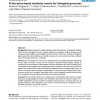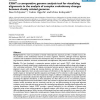BMCBI
2006
13 years 11 months ago
2006
Background: A number of methods that use both protein structural and evolutionary information are available to predict the functional consequences of missense mutations. However, ...
BMCBI
2006
13 years 11 months ago
2006
Background: A transcriptional regulatory module (TRM) is a set of genes that is regulated by a common set of transcription factors (TFs). By organizing the genome into TRMs, a liv...
BMCBI
2006
13 years 11 months ago
2006
Background: Recent analyses in systems biology pursue the discovery of functional modules within the cell. Recognition of such modules requires the integrative analysis of genome-...
BMCBI
2006
13 years 11 months ago
2006
Background: Assessment of array quality is an essential step in the analysis of data from microarray experiments. Once detected, less reliable arrays are typically excluded or &qu...
BMCBI
2006
13 years 11 months ago
2006
Background: Molecular biologists work with DNA databases that often include entire genomes. A common requirement is to search a DNA database to find exact matches for a nondegener...
BMCBI
2006
13 years 11 months ago
2006
Background: Understanding research activity within any given biomedical field is important. Search outputs generated by MEDLINE/PubMed are not well classified and require lengthy ...
BMCBI
2006
13 years 11 months ago
2006
Background: Understanding gene regulatory networks has become one of the central research problems in bioinformatics. More than thirty algorithms have been proposed to identify DN...
BMCBI
2006
13 years 11 months ago
2006
Background: Algorithms that locate evolutionarily conserved sequences have become powerful tools for finding functional DNA elements, including transcription factor binding sites;...
BMCBI
2006
13 years 11 months ago
2006
Background: Providing for long-term and consistent public access to scientific data is a growing concern in biomedical research. One aspect of this problem can be demonstrated by ...
BMCBI
2006
13 years 11 months ago
2006
Background: The recent accumulation of closely related genomic sequences provides a valuable resource for the elucidation of the evolutionary histories of various organisms. Howev...





